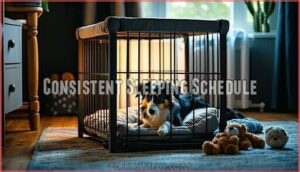This site is supported by our readers. We may earn a commission, at no cost to you, if you purchase through links.
 You can’t actually stop a dog in heat from bleeding completely, but you can manage it effectively.
You can’t actually stop a dog in heat from bleeding completely, but you can manage it effectively.
The bleeding is a natural part of her reproductive cycle that typically lasts 2-3 weeks.
Your best bet is using dog diapers or washable belly bands to contain the mess.
Think of it as nature’s way of saying "renovation in progress" – you can’t stop the construction, but you can put up protective barriers.
Cover furniture with waterproof covers, confine her to easy-to-clean areas, and maintain regular potty breaks.
The bleeding is usually lighter than you’d expect – just a few drops throughout the day.
Spaying remains the only permanent solution if you don’t plan to breed.
Smart management strategies can turn this challenging time into a manageable routine.
Table Of Contents
- Key Takeaways
- Understanding a Female Dog’s Heat Cycle
- Controlling Bleeding in a Dog in Heat
- Natural Ways to Stop a Female Dog’s Period
- Factors to Consider for Bleeding Control
- Can You Stop a Female Dog’s Period?
- How to Keep House Clean When Dog is in Heat
- A Dog Heat Cycle Only Happens Once or Twice a Year
- A Puppy Can Go Into Heat Sooner Than You Think
- Dogs in Heat Should Stay Away From Intact Male Dogs for 3 to 4 Weeks
- Don’t Think You’re in The Clear Once The Bleeding Stops
- Frequently Asked Questions (FAQs)
- How to stop female dog period naturally?
- How to get a dog in heat to stop bleeding?
- Can spaying completely eliminate heat cycle bleeding?
- What age should puppies be spayed?
- Are there emergency situations during heat cycles?
- How long after spaying do symptoms disappear?
- Can older dogs safely undergo spaying surgery?
- Conclusion
Key Takeaways
- You can’t completely stop the bleeding – it’s a natural part of your dog’s reproductive cycle that must run its course over 2-3 weeks, but you can manage it effectively with the right tools and strategies.
- Use dog diapers and protective covers – washable belly bands or disposable diapers contain the mess while waterproof furniture covers and removed rugs protect your home from stains.
- Maintain strict supervision for the full 3-4 weeks – keep your dog away from intact males during the entire cycle, not just when bleeding stops, as she remains fertile and attractive to males even after discharge ends.
- Consider spaying for permanent prevention – it’s the only way to completely eliminate future heat cycles and associated bleeding, while also reducing risks of mammary cancer and life-threatening infections like pyometra.
Understanding a Female Dog’s Heat Cycle
You can’t completely stop a dog’s heat cycle bleeding, but you can manage it effectively with the right approach.
Understanding your dog’s estrus cycle helps you prepare for the 2-4 week period when bleeding naturally occurs during the proestrus phase.
Duration and Frequency of Heat Cycle
Understanding your dog’s heat cycle timeline helps you prepare for the months ahead.
A typical canine heat cycle occurs every six to twelve months, with each cycle lasting approximately 21 days—though this can range from two to four weeks depending on your dog’s size and breed.
Small breeds tend to have shorter cycles, while larger breeds experience longer ones.
The bleeding phase, called proestrus, typically lasts seven to fourteen days, with the heaviest flow occurring during the first week.
This menstrual duration varies between individual dogs, but you’ll notice the discharge gradually lightening as your pet approaches her fertile period.
Fertility peaks mid-cycle during the estrus phase, making breeding frequency considerations essential if you’re not planning puppies.
Your dog’s cycle length remains fairly consistent throughout her life, though first-time heat cycles may show irregular patterns.
Watch for dog heat symptoms like vulva swelling and increased urination alongside the bleeding.
These dog heat cycle indicators help you track where she’s in her reproductive timeline.
Signs and Symptoms of Heat Cycle
Recognition of heat symptoms in your dog becomes vital when you’re managing the canine heat cycle.
Your female dog will display several unmistakable signs that indicate she’s entering this reproductive phase.
Here are the key heat symptoms to watch for:
- Bloody discharge – The most obvious sign, typically lasting 7-14 days with heavier bleeding initially
- Vulva swelling – Noticeable enlargement that decreases as the fertile period approaches
- Increased urination – More frequent potty breaks and potential marking behavior
- Behavioral changes – Heightened affection, restlessness, or aggression toward other dogs
- Fertility signs – Tail flagging and receptive postures around day 10-14
These hormonal changes create a perfect storm of symptoms that’ll have you scrambling for dog heat symptoms solutions.
The bloody discharge varies between dogs, but don’t panic if it seems heavy initially – that’s normal during the first week.
Your dog’s behavior might swing like a pendulum, from clingy to standoffish.
Monitor the vulva swelling closely, as its reduction signals peak fertility approaching.
Understanding male dog behavior is essential to manage interactions during this time.
Managing a Female Dog in Heat
Managing your dog in heat requires a multi-faceted approach that prioritizes both comfort and cleanliness.
Dog diapers or washable blankets serve as your first line of defense for bleeding control, while maintaining consistent dog hygiene helps prevent infections.
Create a calm environment with extra attention and soft bedding to support your pet’s comfort during this challenging time.
Keep intact male dogs away to prevent unwanted mating behaviors.
Establish a regular potty schedule and consider crate training for better canine heat cycle management.
Monitor your dog’s female health closely, watching for excessive bleeding or unusual symptoms that might require veterinary attention.
This thorough canine care approach guarantees your dog stays comfortable while you maintain control over the situation.
Controlling Bleeding in a Dog in Heat
While you can’t actually stop the bleeding during your dog’s heat cycle, you can effectively manage it to protect your home and keep your pet comfortable.
The key is using the right products and techniques to contain the discharge while maintaining proper hygiene throughout the 2-4 week cycle.
Using Dog Diapers or Washable Alternatives
Dog diapers offer the most practical solution for bleeding control during your dog’s heat cycle.
These sanitary products come in disposable and washable options, with washable pads providing eco-friendly alternatives that reduce waste by 80%.
Here’s your three-step approach to diaper success:
- Measure accurately – Check your dog’s waist and hips for proper fit
- Change frequently – Replace every 3-4 hours to prevent infections
- Monitor comfort – Watch for skin irritation or movement restrictions
Washable bedding combined with dog diapers creates double protection for your furniture.
Pet wipes help maintain hygiene between changes, while breed solutions vary based on your dog’s size and bleeding intensity during the dog heat cycle management process.
Effective dog diaper solutions can make a significant difference in managing your dog’s heat cycle.
Removing or Covering Non-Forgiving Surfaces
Protecting your home’s most vulnerable areas requires strategic Surface Protection before your dog’s heat cycle becomes a cleaning nightmare. Hardtoclean surfaces like carpets and upholstered furniture need immediate attention—think of it as creating a fortress against potential stains.
Remove area rugs temporarily or invest in quality Furniture Covers that can handle accidents. Washable slipcovers become your best friend during this time, offering easy maintenance when mishaps occur.
For permanent flooring, focus on Stain Prevention by placing washable blankets in high-traffic areas. Dog diapers provide excellent backup protection, but they’re not foolproof. Keep Floor Cleaning supplies handy for quick responses to accidents.
Sanitary pads designed for dogs offer additional security when combined with other protective measures. Remember, preparation beats desperation—covering surfaces now saves hours of scrubbing later. Understanding normal blood loss is vital for identifying potential health issues in dogs in heat.
Managing Potty Breaks and Activity Indoors
Indoor restrictions become your best friend when managing a dog in heat.
Establish strict potty schedules with frequent, supervised outdoor breaks to prevent accidents.
Activity limits help reduce stress and bleeding intensity.
House training reinforces bathroom routines, while crate management provides safe spaces.
Dog diapers offer backup protection during indoor time.
These strategies facilitate effective dog bleeding management throughout the heat cycle.
Utilizing proper dog hygiene products is vital for maintaining cleanliness and supporting dog hygiene with the right products.
Consistent Sleeping Schedule
Within the comfort of your home, establishing a consistent sleeping schedule helps your dog in heat manage stress and bleeding more effectively. Dogs thrive on routine, and maintaining regular sleep patterns during her heat cycle creates a calm environment that supports natural healing processes.
Set up dedicated rest areas with washable bedding where your dog can relax without worry. Consider crate training if she isn’t already comfortable with it – this provides a secure space while containing any unexpected bleeding episodes. A cozy crate becomes her sanctuary during this challenging time.
Create relaxation techniques by dimming lights during evening hours and keeping her sleeping area quiet. Consistent bedtimes help regulate hormones and reduce anxiety-related bleeding fluctuations. When your dog feels secure in her routine, she’s less likely to experience stress-induced complications.
Remember that dog heat cycle management includes emotional support alongside physical care. A well-rested dog recovers faster and experiences less discomfort. These dog bleeding solutions focus on comfort, making the entire process smoother for both of you.
Natural Ways to Stop a Female Dog’s Period
If you’re looking for natural ways to stop your dog’s heat cycle permanently, spaying is the most effective and healthiest option available.
While you can’t naturally halt an ongoing heat cycle, spaying prevents future cycles and eliminates the associated bleeding and health risks.
Spaying as a Permanent Solution
Looking beyond temporary fixes, spaying offers the ultimate permanent solution to stop your dog’s heat cycle bleeding forever.
This pet surgery eliminates the source of reproductive hormones by removing ovaries and uterus, providing lasting canine bleeding solutions.
Spay benefits include preventing future heat cycles, reducing mammary cancer risk, and eliminating life-threatening pyometra infections.
While veterinary care requires anesthesia risks, this permanent fix transforms dog heat cycle management from recurring challenge to one-time investment in your pet’s long-term health and comfort.
Risks and Benefits of Spaying
Before making the leap into spaying your dog, you’ll want to weigh the spay benefits against potential health risks.
This surgical procedure eliminates dog heat cycles permanently, dramatically reducing mammary cancer risk and preventing life-threatening pyometra infections.
However, spaying isn’t without considerations—some dogs may experience increased appetite leading to weight gain, and certain breeds face higher urinary incontinence risks.
Surgical costs typically range from $200-800, depending on your location and veterinary clinic.
The hormone effects of spaying are significant: estrogen and progesterone production stops entirely, which explains both the protective benefits and potential side effects.
Your veterinarian’s advice is vital here.
They’ll assess your dog’s age, breed, and health status to determine the best timing.
Many vets recommend spaying before the first heat cycle for maximum cancer protection, though this varies by individual circumstances and recent research findings.
Pyometra and Other Health Risks
While spaying offers significant benefits, understanding potential health risks helps you make informed decisions about your dog’s reproductive health.
Pyometra stands as the most serious threat to unspayed females, affecting approximately 25% of dogs by age 10. This life-threatening uterine infection develops after heat cycles when bacteria enter the cervix, causing the uterus to fill with pus.
Pyometra Prevention requires vigilant monitoring and prompt veterinary care when symptoms appear. Dogs with this condition show increased thirst, lethargy, vaginal discharge, and abdominal swelling. Without immediate treatment, the infection progresses to sepsis with mortality rates reaching 50%.
Other health complications include:
- Mammary tumors – Risk increases with each heat cycle
- Urinary tract infections – Higher susceptibility during heat
- Temporary anemia – From blood loss during cycles
- Behavioral stress – Hormonal changes cause irritability
- Unwanted pregnancies – Leading to potential birthing complications
Early spaying eliminates these infection risks while supporting thorough dog reproductive health management.
Factors to Consider for Bleeding Control
When your dog’s in heat, you’ll need to tackle both the physical mess and behavioral changes that come with bleeding.
Managing this challenging time requires a strategic approach that considers your dog’s comfort, your home’s cleanliness, and practical solutions that work for your lifestyle, ensuring your dog’s comfort.
Behavioral Considerations
Dog behavior changes dramatically during heat cycles, creating new challenges for pet owners.
Your dog’s anxiety and irritability may spike as hormonal fluctuations affect her mood.
Watch for increased restlessness management needs—she might pace, whine, or seek constant attention.
Environmental changes like dimmed lighting and quiet spaces support stress alleviation.
Remove stressors such as loud noises or unfamiliar visitors.
Calming techniques include gentle massage and consistent routines.
Monitor mounting behaviors and increased vocalization, which are normal dog heat cycle behavior responses.
Anxiety reduction becomes your priority through patience and understanding.
Keeping The House Clean During Heat
Protecting your furniture and floors becomes your top priority during this messy time.
Use washable slipcovers on couches and chairs, while removing valuable rugs or carpets from your dog’s favorite spots.
Stock up on cleaning supplies specifically designed for pet stains and odor control.
Dog diapers paired with sanitary pads provide double protection, and enzymatic cleaners tackle accidents effectively.
These sanitary measures help maintain a fresh, clean home while keeping your furry friend comfortable throughout her heat cycle, ensuring a clean home.
Additional Tips for Managing a Dog in Heat
Beyond maintaining a spotless home, successful heat management requires attention to your dog’s overall wellbeing and behavior patterns. Your furry friend will likely experience mood swings, increased anxiety, and restlessness during this 2-4 week period.
Here are key strategies for thorough dog heat cycle management:
- Create a calm sanctuary – Set up a quiet space with soft bedding where your dog can retreat when feeling overwhelmed
- Provide mental stimulation – Puzzle toys and scent games help redirect energy and reduce anxiety-driven behaviors
- Monitor for mounting behaviors – Redirect these actions immediately with firm "no" commands and engaging activities
Focus on vulva care by gently cleaning the area with pet-safe wipes to prevent bacterial buildup. This simple hygiene routine supports your dog’s comfort throughout the cycle.
Understanding dogs first heat is vital for effective management.
Remember that rest tips become crucial during heat cycles. Maintain consistent sleeping schedules and avoid overstimulation. Your dog’s body is working overtime with hormonal changes, so anxiety relief through extra attention and patience will make this challenging time more manageable for both of you.
Can You Stop a Female Dog’s Period?
You can’t completely stop a female dog’s period once it begins, but you can manage the bleeding effectively with proper techniques and tools.
While the heat cycle must run its natural course, understanding your options for control and prevention will help you handle this challenging time with confidence.
Duration of Bleeding During a Dog’s Heat
Understanding bleeding duration factors helps you prepare for your dog’s heat cycle effectively.
Most dogs bleed for 7-10 days during the proestrus stage, though this varies substantially.
Small breeds typically experience shorter bleeding periods, while larger dogs may bleed longer.
First heat bleeding often appears heavier and more prolonged than subsequent cycles, which is completely normal.
During cycle stage bleeding, you’ll notice the heaviest flow occurs in the first week, gradually lightening as your dog approaches the fertile estrus phase.
Watch for abnormal bleeding signs like excessive flow lasting beyond two weeks or sudden cessation followed by heavy bleeding.
These breed bleeding differences mean a Chihuahua might bleed for five days while a Great Dane could continue for fourteen days.
Proper bleeding management involves tracking your dog’s individual pattern since dog heat cycle bleeding varies between individuals.
This knowledge enables better bleeding prevention strategies and helps you recognize when veterinary attention might be needed for unusual patterns.
Understanding and managing your dog’s heat cycle effectively requires awareness of these factors to ensure the best care for your pet.
Preventing Pregnancy During Heat
While bleeding duration varies by dog, preventing unwanted pregnancy during your dog’s heat cycle requires strategic planning and consistent vigilance. Supervision is Key during this fertile period, as even brief encounters with intact males can result in pregnancy.
Separate Dogs from all intact males throughout the entire heat cycle, not just during bleeding. Here are your primary Mating Prevention strategies:
- Physical barriers – Use secure fencing and keep your dog indoors during peak fertility days (typically days 9-14)
- Avoid public spaces – Skip dog parks and areas with intact males during heat
- Leashed walks only – Maintain complete control during necessary outdoor time
- Indoor confinement – Create a safe space away from potential mates
- Emergency planning – Keep veterinary contacts accessible for accidental encounters
Spaying Alternatives like hormonal injections exist but require veterinary oversight due to significant side effects. Contraceptive Options carry health risks and aren’t recommended for routine use. The most reliable unwanted pregnancy prevention remains physical separation and environmental control during your dog in heat.
Medication and Its Side Effects
Veterinary professionals may prescribe hormonal treatments to manage your dog’s heat cycle, but these medications carry significant risks.
Progestins like megestrol acetate can reduce bleeding but often cause weight gain, increased appetite, and behavioral changes.
Long-term hormone therapy increases pyometra risk and potential liver toxicity.
Off-label uses of tranexamic acid may help decrease bleeding in specific cases.
Emergency contraception options exist but require immediate veterinary supervision, and these spaying alternatives aren’t permanent solutions and need careful monitoring for adverse effects, including liver toxicity.
How to Keep House Clean When Dog is in Heat
Managing a dog in heat requires proactive steps to protect your home and maintain cleanliness throughout the 2-4 week cycle.
You’ll need to focus on three key areas: safeguarding your furniture and floors, keeping your dog’s genital area clean, and controlling any lingering odors or stains.
Removing or Protecting Surfaces and Furniture
Protecting your home from a dog in heat requires strategic planning and the right materials. Smart pet owners know that prevention beats cleanup every time.
- Floor Protection: Remove area rugs or use washable alternatives during your dog’s cycle
- Furniture Covers: Install waterproof slipcovers on sofas, chairs, and beds for easy washing
- Pet Barriers: Set up gates to restrict access to carpeted rooms and delicate surfaces
- Surface Cleaning: Stock enzymatic cleaners specifically designed for pet accidents and odors
Washable bedding becomes your best friend during this time. Consider sanitary pads designed for dogs as backup protection, especially in areas where furniture covers aren’t practical.
These simple steps maintain dog hygiene while preserving your home’s cleanliness. Using dog diaper products can provide additional protection and convenience for pet owners.
Cleaning The Dog’s Private Area
Regular genital cleaning keeps your dog comfortable and prevents infections during her heat cycle.
Use warm water and dog-safe wipes to gently clean the vulva area daily. Wipe from front to back, avoiding harsh chemicals that irritate sensitive skin.
Dog hygiene practices include changing sanitary pads frequently and monitoring for unusual discharge or swelling that signals complications.
Proper dog care also involves maintaining clean dogs paws to prevent dirt and bacteria from spreading to sensitive areas, which is an important part of overall dog care and helps in preventing infections.
Managing Odors and Stains
Managing odors and stains becomes manageable when you’re prepared for your dog’s heat cycle. Beyond cleaning your dog’s private area, you’ll need effective strategies to tackle household messes.
Here are proven methods for odor control and stain removal:
- Use enzymatic pet odor cleaner on urine marks immediately to prevent repeat marking
- Place air fresheners or essential oil diffusers in well-ventilated areas for continuous freshness
- Spot-clean accidents with pet-safe cleaning products designed for biological stains
- Maintain dog diapers and change them regularly to prevent odor buildup
- Wash bedding and fabric surfaces weekly with pet hygiene-focused detergents
These dog heat cycle hygiene practices keep your home fresh during dog bleeding management periods, and by following these steps, you can ensure a clean and healthy environment for your pet.
A Dog Heat Cycle Only Happens Once or Twice a Year
Understanding your dog’s heat cycle helps you prepare for those messy weeks ahead.
Most female dogs experience their heat cycle only once or twice yearly, typically every 6-12 months.
This relatively infrequent schedule means you’ll have plenty of time between cycles to stock up on dog diapers and prepare your home.
During each heat cycle, bleeding usually lasts 7-10 days, with canine hormones causing fertility peaks mid-cycle.
While this limited frequency makes heat cycle management more manageable than monthly cycles, proper dog bleeding prevention remains essential during each episode.
A Puppy Can Go Into Heat Sooner Than You Think
In the context of puppy development, timing can catch you off guard. Your furry friend might enter her first heat cycle as early as 4 months old, especially smaller breeds, while larger dogs may wait until 12-24 months.
Early breeding isn’t recommended during initial cycles since physical maturity lags behind sexual development.
Watch for these key heat symptoms during canine puberty:
- Swollen vulva with bloody or straw-colored discharge
- Increased urination and excessive genital licking
- Behavioral changes like nervousness or increased vocalization
- Male dog attraction and potential mounting behaviors.
Some puppies experience "silent heat" with minimal bleeding, making detection challenging.
Proper puppy care includes monitoring for these signs and considering spaying before the first cycle to reduce mammary tumor risks later.
Understanding dog heat cycles is essential for effective management and care.
Dogs in Heat Should Stay Away From Intact Male Dogs for 3 to 4 Weeks
Your puppy’s first heat cycle might catch you off guard, but keeping her safe from intact male dogs requires vigilance for the entire 3-4 week period.
Heat cycles hit when you least expect them – stay vigilant for the full 3-4 weeks.
Male Dog Separation isn’t just about preventing unwanted pregnancy – it’s about protecting your female dog from persistent, potentially aggressive suitors who can detect her scent from miles away.
During the complete Heat Cycle Duration, intact male dogs will go to extraordinary lengths to reach a female in heat.
They’ll jump fences, dig under gates, and even break free from leashes.
This makes Female Dog Isolation absolutely critical, not just during the bleeding phase but throughout the entire cycle.
Breeding Precautions should include avoiding dog parks, daycare, and even neighborhood walks where you might encounter males that aren’t on a leash.
Your dog’s flirtatious behavior and mounting tendencies will intensify during this time, making encounters with intact males particularly risky.
Canine Behavior Modification techniques like crate training and creating secure indoor spaces help manage this challenging period.
Remember, even after dog bleeding stops, your dog remains fertile and attractive to males for several more days.
Don’t Think You’re in The Clear Once The Bleeding Stops
When bleeding stops around day 10-14, your dog’s actually entering her most fertile phase.
This isn’t the time to relax your vigilance – she can still get pregnant for another 7-10 days.
Many owners make the mistake of thinking the danger’s passed once the red discharge disappears, but that’s when things get tricky.
Post bleeding care requires continued heat cycle monitoring because hormone regulation keeps her receptive to males.
Those sneaky intact males can still detect her pheromones from blocks away.
You’ll need to maintain the same strict supervision and keep implementing your dog heat cycle care routine.
Watch for subtle behavioral changes like increased friendliness toward males or backing up when touched near her tail.
These signs indicate she’s still fertile.
Don’t let your guard down just because the mess stopped – veterinary guidance confirms this phase poses the highest pregnancy risk.
Proper dog heat problems management means staying alert throughout the entire 21-day cycle.
Frequently Asked Questions (FAQs)
How to stop female dog period naturally?
You can’t truly "stop" a dog’s heat cycle naturally – it’s like trying to stop the sunrise with positive thinking.
However, you can manage bleeding through proper hygiene, dog diapers, and creating a comfortable environment until the cycle completes naturally.
How to get a dog in heat to stop bleeding?
You can’t completely stop the bleeding—it’s natural during heat cycles.
However, you can manage it effectively with dog diapers, regular cleaning, and maintaining good hygiene until the cycle ends naturally.
Can spaying completely eliminate heat cycle bleeding?
Yes, spaying completely stops the heat cycle by removing the ovaries and uterus.
It’s a permanent solution that prevents all future bleeding episodes.
You’ll never deal with heat-related mess again after this procedure.
What age should puppies be spayed?
You should spay your puppy between 4-6 months old, ideally before her first heat cycle.
This timing prevents unwanted pregnancies while allowing proper development.
Consult your veterinarian for the best schedule based on your dog’s breed and size, considering the ideal timing of before her first heat cycle.
Are there emergency situations during heat cycles?
Emergency situations during heat cycles include excessive bleeding that soaks through multiple diapers hourly, signs of pyometra (infection) like vomiting and lethargy, or prolonged bleeding beyond four weeks.
Contact your vet immediately if you notice these warning signs, especially if you observe excessive bleeding.
How long after spaying do symptoms disappear?
After spaying surgery, heat cycle symptoms typically disappear within 24-48 hours once anesthesia wears off.
However, some dogs may show lingering hormonal behaviors for 1-2 weeks as remaining hormones clear their system completely.
Can older dogs safely undergo spaying surgery?
Senior surgeons successfully spay older dogs, though age amplifies anesthesia risks.
Your vet will assess heart, kidney, and liver function through pre-surgical bloodwork.
Most mature dogs tolerate the procedure well with proper monitoring and pain management protocols.
Conclusion
Like a ship’s captain weathering a storm, you can’t stop the natural forces at play, but you can navigate them skillfully.
While learning how to stop a dog in heat from bleeding completely isn’t possible, you’ve now got the tools to manage it effectively.
Dog diapers, protective covers, and consistent routines transform chaos into manageable moments.
Remember, spaying remains your permanent solution if breeding isn’t planned.
With patience and preparation, you’ll sail through this phase successfully.
- https://www.weatherbug.com/weather-forecast/10-day-weather/
- https://www.espn.com/nba/team/_/name/mia/miami-heat
- https://pubmed.ncbi.nlm.nih.gov/29580569/
- https://vetster.com/en/wellness/puppy-puberty-and-heat-cycles-explained
- https://www.reddit.com/r/puppy101/comments/14wnm3s/when_did_your_dogs_get_in_heat/




















